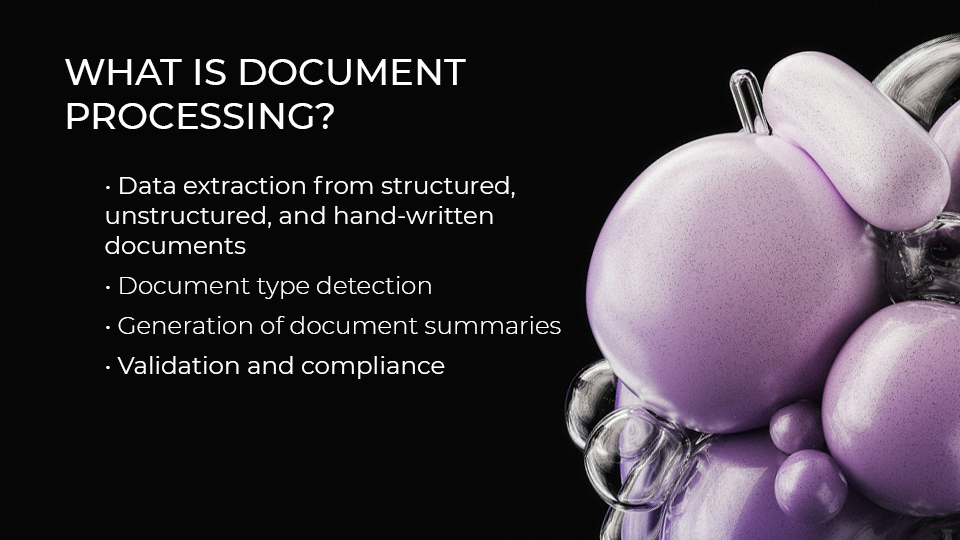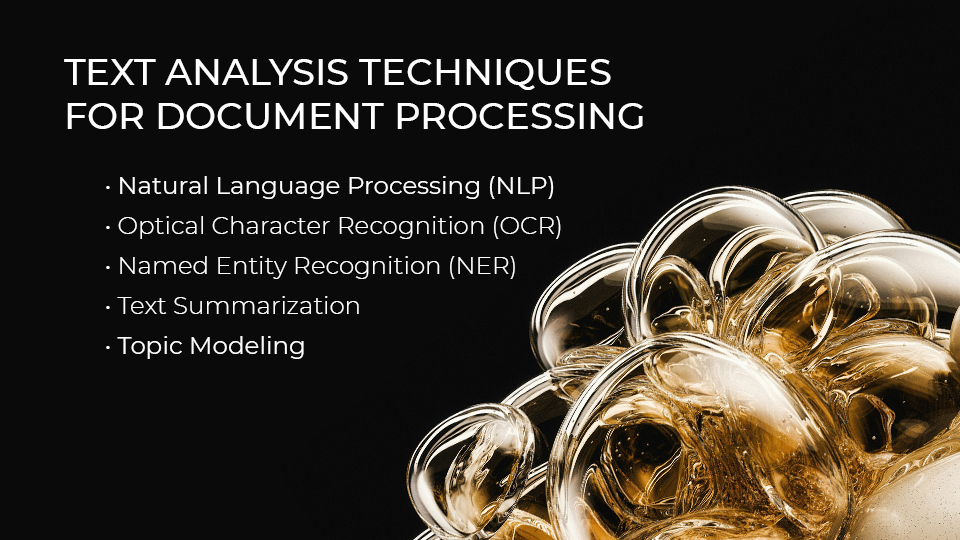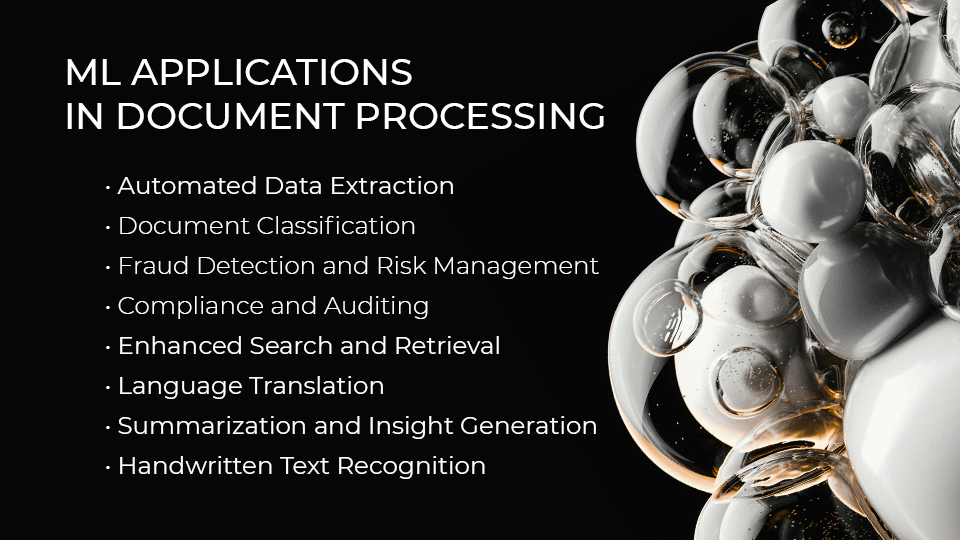In today’s data-driven world, organizations are inundated with vast amounts of unstructured data, much of which resides in documents such as invoices, contracts, emails, and reports. Efficiently processing these documents is critical for businesses to extract actionable insights, ensure compliance, and maintain operational efficiency.
However, traditional document processing methods—often reliant on manual data entry and rule-based systems—are increasingly proving to be time-consuming, error-prone, and ill-suited to handle the scale and complexity of modern data.
Enter Machine Learning (ML) and Text Analysis, two transformative technologies that are revolutionizing the way we process and analyze documents.
By leveraging advanced algorithms and natural language processing (NLP) techniques, these tools enable organizations to automate tedious tasks, improve accuracy, and unlock valuable insights from unstructured text.
Looking for AI developers?
We create AI software — and we do it well. Talk to us to get your project started today
From automating data extraction to classifying documents and detecting anomalies, ML and text analysis are reshaping document processing across industries such as finance, healthcare, legal, and logistics.
This article explores the role of machine learning and text analysis in document processing, delving into the key techniques, applications, and benefits they offer.
Understanding Document Processing
Document processing is the backbone of many business operations, involving the extraction, organization, and analysis of information from various types of documents.
For business owners, the ability to efficiently process documents—whether they are invoices, contracts, emails, or scanned PDFs—can directly impact productivity, compliance, and decision-making. However, traditional methods of document processing often fall short in meeting the demands of modern businesses.
What is Document Processing?
Document processing refers to the systematic handling of documents to extract meaningful data, classify information, and enable actionable insights. It encompasses a range of tasks, including:
- Data Extraction: Pulling specific information (e.g., names, dates, amounts) from unstructured or semi-structured documents.
- Document Classification: Categorizing documents into predefined types (e.g., invoices, legal contracts, HR forms).
- Content Summarization: Condensing lengthy documents into concise summaries for quick review.
- Validation and Compliance: Ensuring documents meet regulatory standards and internal policies.

Types of Documents
Businesses deal with a wide variety of documents, each with its own complexities:
- Structured Documents: Forms or templates with fixed fields (e.g., tax forms, surveys).
- Semi-Structured Documents: Documents with a mix of fixed and variable formats (e.g., invoices, receipts).
- Unstructured Documents: Free-form text with no predefined format (e.g., emails, contracts, reports).
- Scanned or Handwritten Documents: Physical documents converted into digital formats, often requiring Optical Character Recognition (OCR) for text extraction.
Challenges with Traditional Methods
Many organizations still rely on manual data entry or rule-based systems for document processing. These approaches come with significant limitations:
- Time-Consuming: Manual processing is slow and cannot scale with growing data volumes.
- Error-Prone: Human errors in data entry or rule misconfigurations can lead to costly mistakes.
- Inflexible: Rule-based systems struggle to handle variations in document formats or unstructured data.
- High Operational Costs: Maintaining large teams for manual processing or constantly updating rules is expensive.
These challenges highlight the need for a more efficient, scalable, and accurate solution. This is where custom AI systems powered by machine learning and text analysis come into play. By automating document processing, businesses can reduce costs, improve accuracy, and free up valuable resources for strategic initiatives.
Role of Machine Learning in Document Processing
In an era where data is one of the most valuable assets, the ability to process and analyze documents efficiently can be a game-changer for organizations. Machine Learning (ML) has emerged as a powerful tool to address the limitations of traditional document processing methods, offering automation, accuracy, and scalability.
What is Machine Learning?
Machine Learning is a subset of artificial intelligence that enables systems to learn from data and improve their performance over time without being explicitly programmed. Unlike rule-based systems, which rely on predefined logic, ML models can adapt to new patterns and variations in data, making them ideal for handling the complexities of document processing.
Key ML Techniques for Document Processing
Machine Learning offers a variety of techniques to address different document processing challenges. Below is a breakdown of the most commonly used methods, their applications, and their benefits:
|
Technique |
Description |
Applications |
Benefits |
|---|---|---|---|
|
Supervised Learning |
Models are trained on labeled datasets to recognize patterns and make predictions. |
- Document classification (e.g., invoices, contracts). - Data extraction (e.g., names, dates, amounts). |
High accuracy for well-defined tasks. Adaptable to specific business needs. |
|
Unsupervised Learning |
Models identify patterns and groupings in data without labeled examples. |
- Clustering similar documents (e.g., customer feedback by topic). - Discovering hidden patterns in unstructured data. |
No need for labeled data. Useful for exploratory analysis and organizing data. |
|
Deep Learning |
Uses neural networks to handle complex tasks, especially with non-textual data. |
- Handwriting recognition. - Extracting text from scanned documents (OCR). - Contextual understanding (e.g., summarization, sentiment analysis). |
Handles complex, unstructured data. Improves accuracy with large datasets |
Benefits of Machine Learning in Document Processing
Implementing ML for document processing offers several advantages:
- Automation: Reduces the need for manual intervention, allowing teams to focus on higher-value tasks.
- Accuracy: Minimizes errors caused by human oversight or rigid rule-based systems.
- Scalability: Handles large volumes of documents with ease, making it suitable for growing businesses.
- Adaptability: Learns from new data and adjusts to changes in document formats or requirements.
- Cost Efficiency: Lowers operational costs by streamlining workflows and reducing reliance on manual labor.
Why Custom ML Solutions Matter
While off-the-shelf document processing tools can be useful, they often lack the flexibility to address unique business needs. Custom ML solutions, developed in collaboration with skilled AI developers, can be tailored to specific document types, workflows, and industry requirements. For example:
- A financial institution might need a system to extract and validate data from complex loan agreements.
- A logistics company could benefit from an AI-powered tool to process shipping manifests and invoices automatically.
By investing in custom ML systems, organizations can achieve a competitive edge, ensuring their document processing workflows are not only efficient but also aligned with their strategic goals.
Intelligent Document Processing In Action
We build custom AI document processing systems
Text Analysis Techniques for Document Processing
While Machine Learning provides the foundation for automating document processing, Text Analysis is the engine that drives the understanding and extraction of meaningful information from unstructured text. By combining these two disciplines, organizations can unlock the full potential of their document workflows. Below, we explore the key text analysis techniques that are transforming document processing.

Natural Language Processing (NLP)
NLP is the cornerstone of text analysis, enabling machines to understand, interpret, and generate human language. It powers tasks such as:
- Tokenization: Breaking text into individual words or phrases for analysis.
- Part-of-Speech Tagging: Identifying grammatical components (e.g., nouns, verbs) to understand sentence structure.
- Syntax Parsing: Analyzing sentence structure to extract relationships between words.
NLP is essential for tasks like extracting key information from contracts or understanding the context of customer emails.
Optical Character Recognition (OCR)
OCR is a critical tool for converting scanned documents, handwritten notes, or images into machine-readable text. Modern OCR systems, enhanced by ML, can handle:
- Poor-quality scans or low-resolution images.
- Handwritten text with varying styles and legibility.
- Multi-language documents.
OCR is often the first step in processing physical or non-digital documents, making it indispensable for industries like healthcare, legal, and logistics.
Named Entity Recognition (NER)
NER identifies and categorizes specific entities within text, such as names, dates, locations, and monetary values. For example:
- Extracting vendor names and invoice amounts from financial documents.
- Identifying key clauses or parties in legal contracts.
NER is particularly useful for automating data extraction and reducing manual effort in document review processes.
Sentiment Analysis
Sentiment analysis determines the emotional tone or intent behind text, such as positive, negative, or neutral sentiment. While commonly used in customer feedback analysis, it can also be applied to:
- Reviewing internal communications for tone and sentiment.
- Analyzing customer support interactions to identify areas for improvement.
Text Summarization
Text summarization techniques condense lengthy documents into shorter, meaningful summaries. This is especially valuable for:
- Quickly reviewing lengthy reports or legal documents.
- Generating executive summaries for business reviews.
Summarization can be achieved through extractive methods (selecting key sentences) or abstractive methods (generating new sentences that capture the essence of the text).
Topic Modeling
Topic modeling identifies recurring themes or topics within a collection of documents. For example:
- Grouping customer feedback into categories like "product quality" or "shipping issues."
- Analyzing research papers to identify emerging trends in a field.
This technique is particularly useful for organizing and analyzing large volumes of unstructured text.
Tools and Frameworks
To implement these techniques, developers often rely on powerful libraries and frameworks such as:
- spaCy and NLTK for NLP tasks.
- Tesseract and Google Vision API for OCR.
- Hugging Face Transformers for advanced NLP models like BERT and GPT.
- TensorFlow and PyTorch for building custom deep learning models.
By leveraging these tools, organizations can build robust text analysis pipelines tailored to their specific document processing needs.
Applications of ML and Text Analysis in Document Processing
The combination of Machine Learning (ML) and Text Analysis has opened up a wide range of applications that streamline document processing, reduce costs, and improve accuracy. Below are some of the most impactful use cases across industries:

1. Automated Data Extraction
One of the most common applications is the automated extraction of structured data from unstructured or semi-structured documents. For example:
- Extracting invoice details such as vendor names, dates, and amounts.
- Pulling key terms and clauses from legal contracts.
- Capturing patient information from medical records.
By automating this process, organizations can significantly reduce manual effort, minimize errors, and accelerate workflows.
2. Document Classification
ML models can automatically categorize documents into predefined types, such as:
Classifying incoming emails into categories like "customer support," "sales inquiries," or "billing issues."
- Sorting financial documents into types like invoices, receipts, or bank statements.
- Organizing legal documents by case type or jurisdiction.
This capability ensures that documents are routed to the appropriate teams or systems, improving efficiency and reducing processing time.
3. Fraud Detection and Risk Management
ML algorithms can analyze documents to identify anomalies or patterns indicative of fraud or risk. For instance:
- Detecting discrepancies in financial statements or expense reports.
- Flagging suspicious clauses in contracts or insurance claims.
- Monitoring compliance with regulatory requirements.
These applications are particularly valuable in industries like finance, insurance, and healthcare, where accuracy and compliance are critical.
4. Compliance and Auditing
Ensuring that documents meet regulatory standards is a time-consuming but essential task. ML and text analysis can:
- Automatically verify that contracts adhere to legal or industry standards.
- Identify missing or non-compliant information in regulatory filings.
- Generate audit trails and reports for compliance purposes.
This not only reduces the risk of non-compliance but also simplifies the auditing process.
5. Enhanced Search and Retrieval
Traditional keyword-based search systems often struggle with unstructured documents. ML-powered search engines can:
- Understand the context of search queries, improving relevance.
- Retrieve documents based on semantic similarity rather than exact keyword matches.
- Enable cross-document analysis by linking related information.
This is particularly useful for legal teams, researchers, and knowledge management systems.
6. Language Translation
Global organizations often deal with documents in multiple languages. ML-powered translation tools can:
- Automatically translate contracts, emails, or reports into the desired language.
- Preserve the meaning and context of the original text.
- Support real-time translation for multilingual communication.
This capability breaks down language barriers and facilitates international collaboration.
7. Summarization and Insight Generation
For decision-makers, quickly understanding the content of lengthy documents is crucial. Text summarization techniques can:
- Generate concise summaries of reports, research papers, or meeting notes.
- Highlight key points or action items in legal or financial documents.
- Provide executives with actionable insights without requiring them to read entire documents.
This application saves time and ensures that critical information is not overlooked.
8. Handwritten Text Recognition
In industries like healthcare, logistics, and education, handwritten notes and forms are still prevalent. ML-powered systems can:
- Convert handwritten text into machine-readable format.
- Extract relevant information from forms, prescriptions, or delivery notes.
- Improve accuracy even with challenging handwriting styles.
This eliminates the need for manual transcription and speeds up data entry processes.
Challenges and Limitations
While Machine Learning (ML) and Text Analysis offer significant advantages for document processing, implementing these technologies is not without its challenges. Understanding these limitations is crucial for organizations planning to develop custom AI systems. Below are some of the key challenges and considerations:
1. Data Quality and Availability
Challenge: ML models rely heavily on high-quality, labeled data for training. Poor-quality data—such as incomplete, inconsistent, or noisy documents—can lead to inaccurate results.
Solution: Organizations must invest in data cleaning and preprocessing to ensure their datasets are reliable. In some cases, acquiring sufficient labeled data may require significant effort or third-party resources.
2. Complexity of Document Formats
Challenge: Documents come in a wide variety of formats, including scanned images, handwritten notes, PDFs, and emails. Each format presents unique challenges, such as low-resolution scans or non-standard layouts.
Solution: Custom AI systems must be designed to handle diverse formats, often requiring a combination of techniques like OCR, NLP, and computer vision.
3. Handling Unstructured Data
Challenge: Unstructured documents, such as free-form text or contracts, lack a predefined format, making it difficult to extract information consistently.
Solution: Advanced NLP techniques, such as Named Entity Recognition (NER) and topic modeling, are essential for processing unstructured data effectively.
4. Bias in ML Models
Challenge: ML models can inherit biases present in the training data, leading to unfair or inaccurate outcomes. For example, a model trained on biased legal documents might produce skewed results.
Solution: It’s critical to audit training data and model outputs for bias, ensuring fairness and inclusivity in document processing systems.
5. Computational Resources
Challenge: Training and deploying ML models, especially deep learning models, require significant computational power and storage. This can be a barrier for organizations with limited IT infrastructure.
Solution: Cloud-based solutions and scalable infrastructure can help mitigate these challenges, but they come with associated costs.
6. Integration with Existing Systems
Challenge: Integrating custom AI systems with legacy software or workflows can be complex and time-consuming.
Solution: A phased implementation approach, coupled with APIs and modular design, can ease integration and minimize disruption to existing processes.
7. Maintenance and Updates
Challenge: ML models require ongoing maintenance to remain accurate and relevant. Changes in document formats, business requirements, or regulatory standards may necessitate frequent updates.
Solution: Organizations should plan for continuous monitoring, retraining, and updating of models to ensure long-term effectiveness.
8. Ethical and Privacy Concerns
Challenge: Document processing often involves sensitive information, raising concerns about data privacy and security.
Solution: Robust data encryption, access controls, and compliance with regulations like GDPR or HIPAA are essential to protect sensitive information.
9. Cost of Development
Challenge: Developing custom AI systems can be expensive, particularly for organizations with limited in-house expertise.
Solution: Partnering with experienced AI developers or leveraging pre-built solutions can help reduce costs while ensuring high-quality results.
Why choose Businessware Technologies as your software development company?
- Businessware Technologies is a reliable AI development vendor: it has been recognised as one of the top software development companies by Clutch and Manifest, it is a Top Rated Plus agency Upwork, and has received local awards for its excellent work,
- A team of over 70 highly skilled software engineers with extensive experience in developing complex software for both startups and Fortune 500 companies,
- Deep expertise in modern AI technologies and approaches to system development, like data science, machine learning, OpenCV, Python, Tesseract, and many more,
- Businessware Technologies is a Microsoft Gold Certified partner,
- Businessware Technologies is compliant with GDPR, ISO 9001, ISO 27001 standards,
- Businessware Technologies works with Fortune 500 companies and has had decades-long relationships with most of its clients,
- Businessware Technologies has proven to be a reliable AI outsourcing partner by having an excellent track record in AI and ML development backed by an extensive portfolio of successful projects.
If you have an AI project in mind and need help with implementation, contact our manager and they will be happy to help you.